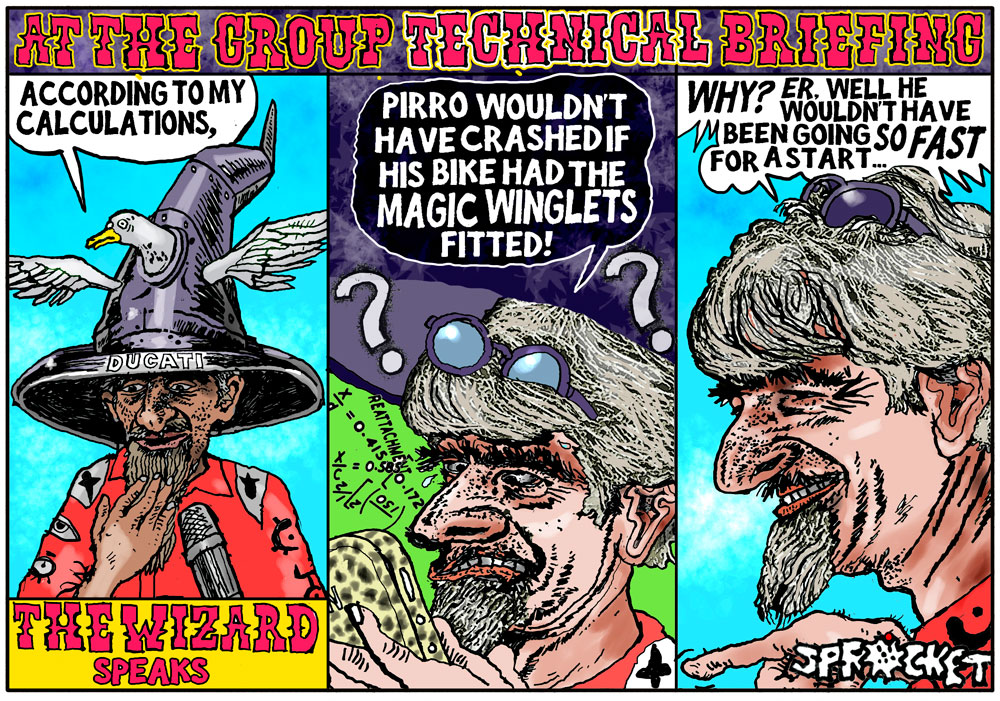Michael Scott | August 15, 2018
Silence Is Golden, Even When You’re Talking
COLUMN
Who says racing lacks humor? Dorna has a way of addressing any such perception. Each year at Brno, after the summer break, they lay on a very subtle exercise in comedy, a show for connoisseurs of understated wit.
It is the “group technical briefing,” where each MotoGP manufacturer sends a delegate to face probing questions from an unwisely optimistic press.

As if any one of them is going to voluntarily reveal technical secrets, let alone when sitting alongside all his rivals.
Once there was a time when race engineers were proud of their innovations and ideas and they happily talked about them. Especially with the old two-strokes, which would often respond better to the input of a lone eccentric in a shed than a whole open-plan roomful of drawing boards and fresh university students (the late Helmut Fath a prime example). These days, like the two-strokes, are gone.
The Japanese companies have long been famous for secrecy beyond the call of duty, often achieved by pretended incomprehension. Nothing defeats curiosity like a well-constructed language barrier. There is much to be lost in miss-translation.
But Ducati has taken it to new heights, with special screens hiding their bikes from sight in the pit box—in case somebody might spy something important if they so much as take a wheel off.
Thus the conference is hilarious in concept. It is even funnier in execution, as an international symposium of pretending to answer questions without actually saying anything.
Yamaha’s guy, Kouji Tsuya, evoked sentimental memories of old-school Japanese disinformation. His command of English (I think it was English) became for the occasion so personalized that understanding was almost impossible.
It took repetitive and painstaking analysis of the recording to unravel his opinion that the reason Yamaha had not won in over a year was because “our bike is not at a level to win.” I am confident this obfuscation was deliberate, and that his communication skills are much sharper when required, for example when negotiating contracts.
Yamaha’s secrets were safe in his hands.
Suzuki’s big chief, Shinichi Sahara, is another usually well-spoken figure who also became uncharacteristically tongue-tied, in the face of any meaningful questions.
Honda’s tech director Takeo Yokoyama displayed the contrasting modern side of Japanese reticence. Eloquent and unafraid to reveal a sense of humor, he had ways of saying absolutely nothing, with style and a fashionable haircut. It had the same effect.
From Aprilia, Romano Albesiano gave a perfect demonstration of the art of circumlocution: simultaneously articulate but secretive. If motorcycle racing ever palls, he has a career waiting in the murky world of Italian politics.
KTM is based in Austria, and tech director Sebastian Risse was suitably more straightforward. Even blunt. I asked about the reverse-crank engine, which everybody knows was raced earlier in the year by Mika Kallio and also tested after the Jerez outing by Pol Espargaro. No hesitation as he looked me in the eye and disclosed that he was not able to confirm anything whatsoever about specifications, past experience or future plans.
Well, thanks for that, Seb. Makes you wonder why he came. Or any of us.
But there was a refreshing streak of honesty, too. Talking about the letter and the application of the new and clearly ineffective aerodynamic rules, he said that if any of the delegates had been shown photographs of some of the current bikes when these supposedly more-restrictive regs were framed last year, “we would have said they were not within the rules.”
This applies as much to Honda and Yamaha, with their sideways-vee double wings as to Ducati, who the same day launched their latest aero body, with double box kites on each side.
Aerodynamics? Step forward goatee-bearded Ducati Corse mastermind Gigi Dall’Igna, wizard of the winglets, the doctor of downforce.
Dall’Igna is increasingly miffed at the restrictions, and his weary first response to questions was: “I think we’ve talked too much about aerodynamics. It’s difficult to say more.” Well, Gigi, you started it.
In fact, his railing against ever-changing rules was hard to disagree with, but his assertion that Michele Pirro’s horrible high-speed crash at Mugello “with proper aerodynamics would not have happened” was more than slightly disingenuous.
Pirro was thrown over the bars at more than 200 mph after a big wobble had spread his brake pads; his panicky second handful locked the front wheel. There is some merit in Dall’Igna’s assertion: the wobble might not have happened if the front was properly anchored by the wind. But since the team had sent their test rider out using the fairing option without even the restricted wings of 2018, it rings a bit hollow.
In any case, Dall’Igna makes the mistake that racing is about engineering and valuable research. Wrong. It’s about comedy.CN